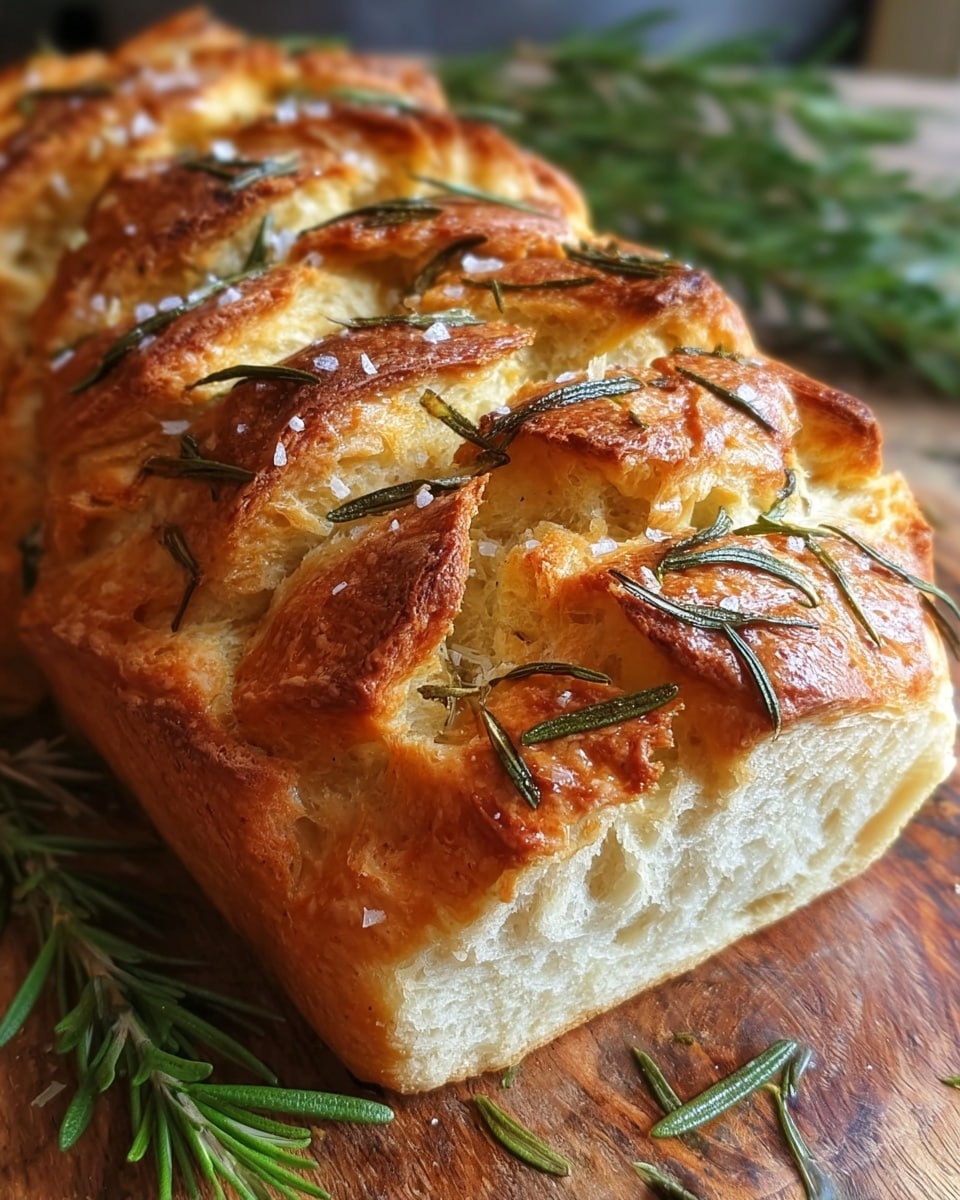Homemade Rosemary Bread Recipe
Introduction
Homemade Rosemary Bread is a fragrant and flavorful loaf that fills your kitchen with the comforting aroma of fresh herbs. With simple ingredients and straightforward steps, it’s an inviting recipe perfect for sharing or enjoying yourself.

Ingredients
- 4 cups of all-purpose flour
- 1 packet of active dry yeast
- 1 1/2 cups of warm water
- 2 tablespoons of fresh rosemary, chopped
- 1 teaspoon of salt
- 1 tablespoon of olive oil
Instructions
- Step 1: In a large mixing bowl, combine the warm water and yeast. Let it sit for about 5 minutes until it becomes frothy.
- Step 2: Add the flour, salt, chopped rosemary, and olive oil to the yeast mixture. Stir until a shaggy dough forms.
- Step 3: Knead the dough on a floured surface for about 10 minutes until it becomes smooth and elastic.
- Step 4: Place the dough in a greased bowl, cover it with a clean towel, and let it rise in a warm place for about 1 hour or until doubled in size.
- Step 5: Punch down the dough and shape it into a round loaf. Place the loaf on a baking sheet, cover it, and let it rise for another 30 minutes.
- Step 6: Preheat your oven to 400°F (200°C). Make a few slashes on the top of the loaf with a sharp knife and bake for 30-35 minutes or until golden brown.
- Step 7: Remove the bread from the oven and let it cool before slicing and serving.
Tips & Variations
- Use fresh rosemary for the best flavor, but dried rosemary can also be used in a pinch.
- Make sure your yeast is fresh and active to ensure a good rise in the dough.
- Don’t skip the kneading process; it helps develop the gluten in the dough for a better texture.
- Let the dough rise in a warm, draft-free place to ensure a successful proofing.
- Try adding a handful of chopped olives to the dough for a salty twist.
- Mix in some grated Parmesan cheese for a rich and savory flavor.
- Swap rosemary with other herbs like thyme, oregano, or basil for different aromas.
- Sprinkle honey and sea salt on top before baking for a touch of sweetness.
Storage
Store the bread in an airtight container or wrapped in a clean kitchen towel at room temperature for up to 2 days. For longer storage, slice and freeze the bread, then toast or warm slices as needed. To reheat, warm in the oven at 350°F (175°C) for about 10 minutes to restore freshness.
How to Serve

Serve this delicious recipe with your favorite sides.
FAQs
Can I use dried rosemary instead of fresh?
Yes, dried rosemary can be used if fresh is unavailable. Use about one-third of the amount since dried herbs are more concentrated in flavor.
How do I know if the yeast is still good?
To test yeast, mix it with warm water and a small amount of sugar. If it becomes bubbly and frothy within 5-10 minutes, it is active and good to use. If not, it’s best to replace it.
PrintHomemade Rosemary Bread Recipe
Homemade Rosemary Bread is a fragrant and flavorful loaf made with basic ingredients like all-purpose flour, fresh rosemary, and olive oil. The bread features a soft, elastic crumb with a golden crust, perfect for sharing or serving alongside meals. This recipe guides you through the process of proofing, kneading, and baking the dough to achieve a rustic, aromatic bread that’s simple yet impressive.
- Prep Time: 15 minutes
- Cook Time: 30-35 minutes
- Total Time: 2 hours 20 minutes
- Yield: 1 loaf (about 12 slices) 1x
- Category: Bread
- Method: Baking
- Cuisine: American
- Diet: Vegetarian
Ingredients
Dry Ingredients
- 4 cups all-purpose flour
- 1 packet active dry yeast (about 2 1/4 teaspoons)
- 1 teaspoon salt
- 2 tablespoons fresh rosemary, chopped
Wet Ingredients
- 1 1/2 cups warm water (about 110°F/43°C)
- 1 tablespoon olive oil
Instructions
- Activate the Yeast: In a large mixing bowl, combine the warm water and active dry yeast. Let the mixture sit for about 5 minutes until it becomes frothy, indicating the yeast is active and ready to work.
- Combine Ingredients: Add the all-purpose flour, salt, chopped fresh rosemary, and olive oil to the frothy yeast mixture. Stir until the ingredients come together into a shaggy dough.
- Knead the Dough: Transfer the dough to a floured surface and knead for about 10 minutes until the dough is smooth, elastic, and no longer sticky. This develops the gluten for a better bread texture.
- First Rise: Place the kneaded dough in a greased bowl. Cover it with a clean towel and let it rise in a warm, draft-free place for approximately 1 hour, or until it has doubled in size.
- Shape the Loaf: Punch down the risen dough to release excess air. Shape it into a round loaf and place it on a baking sheet. Cover again and allow it to rise for an additional 30 minutes.
- Preheat Oven and Prepare Bread: Preheat your oven to 400°F (200°C). Before baking, make several slashes on top of the loaf with a sharp knife, allowing steam to escape and aiding in crust formation.
- Bake: Bake the bread in the preheated oven for 30 to 35 minutes, or until the loaf turns golden brown and sounds hollow when tapped on the bottom.
- Cool and Serve: Remove the bread from the oven and transfer to a cooling rack. Allow it to cool completely before slicing to ensure the texture sets properly.
Notes
- Use fresh rosemary for the most vibrant flavor; dried rosemary can substitute but use slightly less as it is more concentrated.
- Ensure your yeast is fresh and activated to guarantee a proper rise.
- Kneading is essential to develop gluten, which provides structure and chewiness to the bread.
- Proof the dough in a warm, draft-free environment to encourage optimal rising.
- Experiment with adding ingredients such as chopped olives, grated Parmesan, or alternative herbs like thyme or oregano for unique flavors.
- For added sweetness, consider brushing the loaf with honey and sprinkling sea salt before baking.
- Let the bread cool fully before slicing to avoid a gummy texture.
Keywords: Homemade Rosemary Bread, Rosemary Bread, Bread Recipe, Fresh Rosemary Bread, Homemade Bread, Rustic Bread, Flavored Bread








